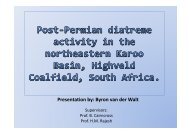coaltech upper olifants river catchment wetland inventory ...
coaltech upper olifants river catchment wetland inventory ...
coaltech upper olifants river catchment wetland inventory ...
You also want an ePaper? Increase the reach of your titles
YUMPU automatically turns print PDFs into web optimized ePapers that Google loves.
Category 3 plant invaders are plants that are proven to have the potential of becoming<br />
invasive. These plants are however, popular garden plants (ornamentals or shade trees) and<br />
it will take a long time to replace these species. Category 3 plants are not allowed to occur<br />
anywhere, unless the plants were already in existence when the regulations came into effect.<br />
The conditions for the plants to remain is that all reasonable measures are taken to prevent<br />
the spread of the species and that none of the plants occur within 30m of the 1:50 year flood<br />
zone of any <strong>wetland</strong>s or water courses. No propagative material of these plants may be<br />
planted, imported or transported in any way. It is however, legal to trade the wood of these<br />
plants, as well as other products that do not have the potential to grow (Landcare South<br />
Africa).<br />
Table 4. List of invasive species observed in the <strong>wetland</strong>s of the UORC.<br />
Species name Common name Category<br />
Acacia dealbata Silver Wattle 2<br />
Acacia mearnsii Black Wattle 2<br />
Azolla filiculoides Azolla, Red Water Fern 1<br />
Cirsium vulgare Scotch Thistle 1<br />
Populus species Poplar 2<br />
Salix babylonica Weeping Willow 2<br />
Sesbania punicea Red Sesbania 1<br />
Solanum eleagnifolium Silver-leaf Bitter Apple 1<br />
Solanum sisymbriifolium Wild Tomato / Dense-thorned Bitter<br />
Apple<br />
Xanthium spinosum Spiny Cocklebur 1<br />
Xanthium strumarium Large Cocklebur 1<br />
3.6.9.2 Forestry<br />
Forestry is restricted to only a few areas in the <strong>catchment</strong> and the most common trees in<br />
these forestry plantations are Poplars (Populus sp) and Eucalyptus (Eucalyptus sp). These<br />
exotic species utilise more water than the indigenous vegetation, and the presence of these<br />
plantations in close proximity to the <strong>wetland</strong>s lowers the water level in the <strong>wetland</strong>s and can<br />
cause drying out of previously permanent zones. The plantations change the habitat of a<br />
variety of <strong>wetland</strong> species and may threaten rare populations (Palmer et al 2002, Van Wyk<br />
pers com 2000).<br />
Wetland Database for UORC - 53 -<br />
1




